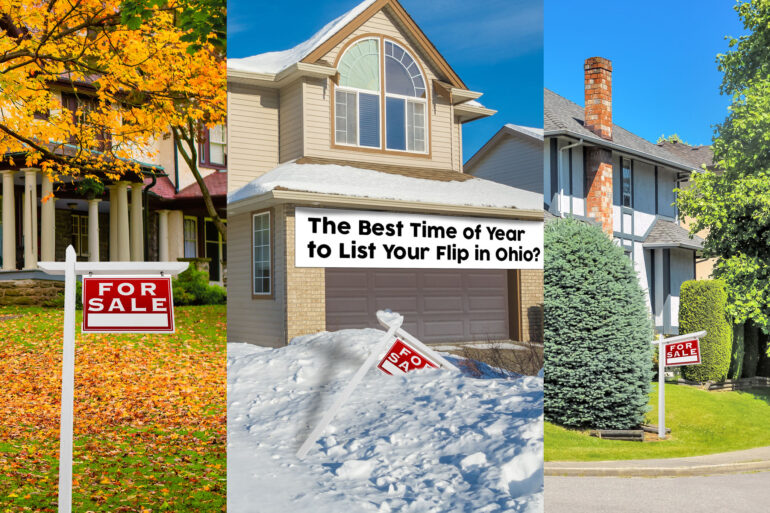What Is the Best Time of Year to List Your Flip in Ohio?
Many sources agree that the most critical factors for investing in real estate include the location of the property, the accuracy of the valuation, having a clearly defined purpose or strategy, and several others. One important element, particularly among sellers, is having the property listed during the spring and early summer months — when sales activity usually peaks.
Of the homes sold during 2022 in the U.S., roughly 8.4% of these properties were flipped by investors — the highest level in more than 15 years. The model employed by home-flipping investors is often described as a transactional, wholesale strategy and follows three basic steps that include buying a property, making improvements, and reselling the property.
While the number of flipped properties reached new heights in 2022, the return-on-investment (ROI) levels sunk to their lowest point since 2008, stemming from a mix of many factors. Here, we will look at one issue that might impact the profitability of a flip: What is the best time of year for listing them?
May has been the busiest month for overall home sales across the state in recent years.
Best Months for Selling Homes in Ohio
Home sales activity is typically highest during the spring and summer months in Ohio. May has been the busiest month for overall home sales across the state in recent years. For example, homes sold in roughly 31 days during May 2021 and 26 days in May 2022. In comparison, selling a home took approximately 43 days in January 2022 — nearly a 40% increase.
Best time for selling a home in Ohio’s largest housing markets
| City | Best Month: Highest Sales Price | Best Month: Fastest Sales Time |
| Akron | August (+7.4 %) | May (+12 days) |
| Cincinnati | June (+11.34 %) | May (+23 days) |
| Cleveland | June (+6.81 %) | June (+12 days) |
| Columbus | April (+7.49 %) | June (+16 days) |
| Dayton | March (+13.03 %) | May (+8 days) |
Looking at the national data, late spring and early summer are also typically the busiest months for home sales. Based specifically on 2022 data, homes sold for the highest sales prices in May — at approximately a 12.6% higher premium. The two slowest months for home sales nationally were October and December.
Because of the tough Ohio winters, investors are often unable to make needed improvements and complete home renovation projects.
Can I Sell a Flipped Home During the Winter Months?
Yes. Houses will sell during the winter months; however, many investors have contrary opinions.
Some investors find listing their properties during the winter months advantageous. Demand, particularly during the holiday months, tends to slow significantly, as people are hesitant to venture out to look at available homes and are often reluctant to endure moving in wintry conditions. Other challenges for sellers during the winter months involve shorter days with limited daylight and a reluctance to move among buyers with children during a current school year.
With fewer homes listed, buyers have more limited options. Those shopping for a home in the winter might be highly motivated, such as those who must relocate for a new job. Lenders might also offer potential sellers more attractive interest rates during the slow winter months.
Seasonal repair and improvement concerns in Ohio
Because of the tough Ohio winters, investors are often unable to make needed improvements and complete home renovation projects. This applies to digging projects, such as those involving water lines, sewer lines, and buried electrical supplies. Pouring footings and foundations is not recommended during the winter months, so projects involving concrete driveways and walkways must wait until spring. Exterior painting during the winter months is also very challenging.
Investors who rely on mortgage financing commonly struggle when competing with those paying cash.
Is Ohio a Good State for Flipping Homes?
Yes. Figures from ATTOM Data Solutions show that the average home flip in Ohio for 2022 returned roughly a 25% profit. Nationally, profits (ROI) from flipping homes were roughly 25% in Q1 of 2022 and 29% in Q2 of 2022.
The market can get competitive in Ohio for home flipping, particularly in acquiring (buying) homes to flip. For example, approximately 74% of investors that flip homes in Cleveland and Cincinnati are cash buyers, which exceeds the national average of roughly 60%. Investors who rely on mortgage financing commonly struggle when competing with those paying cash.
The overall housing market in Ohio remains strong, which is good news for those flipping homes. Although interest rates rose to the highest levels in years during 2022, Ohio’s housing market continues demonstrating resiliency. For example, according to Ohio REALTORS, the average sales price was approximately 2.5% higher in March 2023 compared to March 2022. Year-to-date increases during the same period applied in 11 of the 15 primary housing markets in Ohio.
The volume of distressed properties available for flipping in Ohio
Investors who flip houses often prefer purchasing distressed properties — capitalizing on significantly reduced prices. Examples might include homes in need of structural repairs, foreclosures, inherited properties, etc. Among U.S. states in 2022, Ohio had the fourth-highest foreclosure rate. Approximately 1 of every 3,027 homes in Ohio was in some stage of foreclosure in December 2022.
Keep in mind that this process is a rule of thumb, and plenty of room for problems exists.
Understanding the 70% Rule for House Flipping
Many investors place less emphasis on seasonal concerns and adhere to some traditional financial guidelines, such as the 70% rule for home flipping, which is a tool for assessing whether a purchasing opportunity is a good value.
The rule states that buyers should pay no more than 70% of the property’s estimated after-repair value (ARV). The process involves estimating the amount that a property could sell for after improvements are completed. Consider the basic formula:
ARV x .70 – costs of improvements/repairs = maximum purchase price
Keep in mind that this process is a rule of thumb, and plenty of room for problems exists. The recent COVID-19 pandemic is one example of how an investor might encounter serious financial trouble. During the pandemic, the costs of construction and remodeling projects soared amid a labor shortage and a scarcity of materials.
Other realistic concerns might involve the possibility of an abrupt decline in prices within the local housing market or buyers might significantly underestimate the costs of necessary repair projects. Based on potential changes and uncertainties, many wise investors encourage making conservative estimates that allow a financial cushion.
Financial Pressure Often Dictates the Timing of Listing Your Flip
The concept of listing your flip for selling during a particular time of year is a viable strategy; however, it may be an impractical or unrealistic consideration. Why? An investor in the process of flipping a home often faces financial pressure, with cash being tied up and expenses, such as property taxes, insurance, utilities, and mortgage interest, actively eroding their ROI.
Timing is critical for success; however, not in terms of when you ultimately list a flip for sale.
Listing your flip in Ohio
In summary, let’s take a realistic look at the fundamental nature of house flipping as a way of real estate investing, the current and projected outlook of Ohio’s real estate market, and assess the importance of listing your property during the right time of year.
Estimates suggest that the home flipping process of buying, renovating, and selling a property averages six months. This means that investors seeking to list their flip during the early stages of peak sales activity in April or May should purchase properties no later than approximately November of the prior year.
Flipping homes is inherently a short-term model or strategy. In most cases, the owner of a flip cannot and should not view the timing of their listing casually — such as a homeowner that wants to move might. The owner of a flip might see their profit diminish with each passing month from unavoidable interim expenses.
The real property values in the major Ohio housing markets should remain moderately strong in the near future, largely because a housing deficit exists. Further, many of those flipping homes are not buying from the MLS. With many of the most profitable flips, the investor buys distressed properties — those with apparent flaws that are acquired as-is. Remember, Ohio’s housing market has and should continue to offer plenty of these opportunities.
Although the ROI for house flipping reached 53% during the 2016 heyday, that level of profitability is not likely sustainable. The current ROI levels of 25 to 30% are probably the longer-term reality and most people would agree that this represents a good return for any short-term investment.
Timing is critical for success; however, not in terms of when you ultimately list a flip for sale. Rather, identifying potentially discounted properties, accurately assessing the profitability, and moving quickly amid the competition are key.
Those relying on financing may struggle to compete in Ohio’s market where more than half of investors are cash buyers. This concern is potentially exacerbated now with interest rates in the 7% range.








